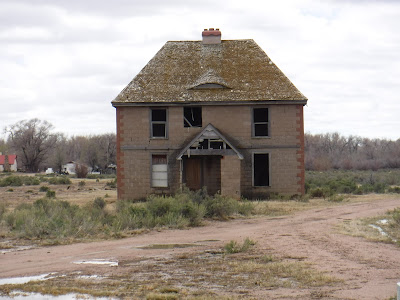 |
| Highway of Legends! |
Colorado's Scenic Byways always take you somewhere really cool and unusual! This route, the Highway of Legends, loops around the two
Spanish Peaks which tower over the region. I drove from Trinidad in south Colorado clockwise around these mountains to Walsenburg, following Colorado Highway 12 and US 160. West Spanish peak has an elevation of 13,626 feet with the East Spanish Peak topping out at 12,683 feet. The 17, 855 acre
Spanish Peaks Wilderness Area includes both summits and offers great hiking and backpacking opportunities.
Click HERE for more of the legends and stories about the area. Geologic information about the spectacular dikes formed in the region are available
HERE.
The first part of the loop, starting outside of Trinidad was very much like driving through Appalachia with visible seams of coal in the roadside cuts and oppressive poverty with abandoned buildings and junked cars providing homes for weeds in the unkempt yards. There was much poverty here, with much money in the land up and away from the road, funding weekend farms and get away cabins just up the mountain behind them.
 |
| Welcome to Cokedale |
After passing the entrances for the Trinidad Lake State Park, you arrive at
Cokedale, surrounded with man-made mountains of slag and the old coke oven structures. Over 140 people now live here full time in the towns historic mining houses, the community was placed on the National Historic Register in 1984. The American Smelting and Refining Company had sold the land and homes to the miners at reduced prices.
A quick drive takes you through Cokedale's community neighborhoods, by the old school house, and around the old miner's office and the (privately owned) Gottlieb Mercantile Company. This was once a model mining community with a population of 1500 in 1909. Founded in 1906, it operated over 40 years to when the company sold out in 1947 due to a decrease in the sale of coal. During those years the coke ovens ran 24 hours daily. 2 mines provided coal from above the town with another providing coal from a few miles away. Coke was made by first washing the mined coal, then cooking the coal to remove impurities and moisture, so it will burn hotter in the iron smelters to make steel. Slag is the byproduct of coke, and is mostly made up of slate and sulfur. There used to be a trolley into Trinidad, serving the miners, costing a quarter for the 1.5 hour ride.
 |
| Coal Washery remains |
 |
| The rows of Coke Ovens |
 |
| Gottlieb Mercantile Company |
 |
| Mounds of slag |
The road out of town runs along the
Purgatoire River, twisting and turning along with the old railroad cut on the southern shore. I pass a modern and working coal mine on the left. Finally I get to Stonewall, where I turn north along the loop around the mountains. Stonewall is named for the stone wall that abuts it, which was created by an uplifted wall of lava which had formed in cracks in the ground. This town looks like one of those 1960's camping vacation towns, with cabins and hotels tucked into the heavily wooded forest. The actual stone wall the town is named for splits so the road can pass through it. I paused to eat lunch in the car (it was cold outside) in a lodge parking lot. Across highway 12 was a gate marking the entrance to where WWII German Officer Prisoners of War were kept. The town smelled of pine trees and the whole community appeared to be waiting to open for the season.
 |
| The stone wall at Stonewall |
 |
| Through these gates were kept WWII Prisoners |
Driving onward, the road past the stone wall makes a right turn and immediately begins climbing up to
Cucharas Pass at 9938 feet elevation (the sign there reads 9995 feet elevation) and the intersection with Forest Service Road NF 46 or FR 415 or Road 364, all numbers are listed on my maps. There are no houses here, just trees, rock walls and snow. And views!
Just a few miles on down the road is the Town of Cuchara in three separate areas. You can check out the local places like Dakota Dukes or the Cuchara Country Store while in the area.
Following Highway 12 on down the mountain brings you past several of the stone dikes, one with Gollum stuck in it : )
 |
| One of the many mountain lakes along Highway 12 |
 |
| Lots of Aspen, pines and views |
 |
| That's Gollum in the dike!!! |
My drive encountered sunny, cloudy, rainy and snowy conditions but with the roads being cleared, was an easy drive in a 2 wheel drive car.
Near highway 160 you find La Veta, another fine mountain community nestled along the base of the Spanish Peaks. Taking a right along US 160 takes you to Walsenburg and the end of the Highway of Legends.
 |
| The Spanish Peaks under snow |






















